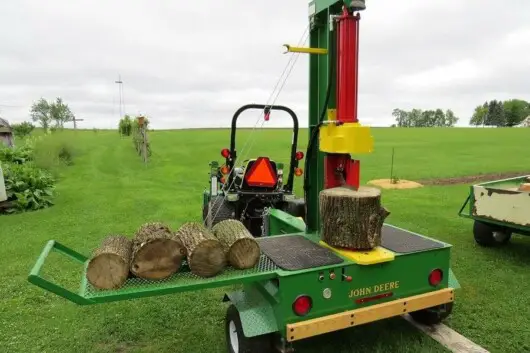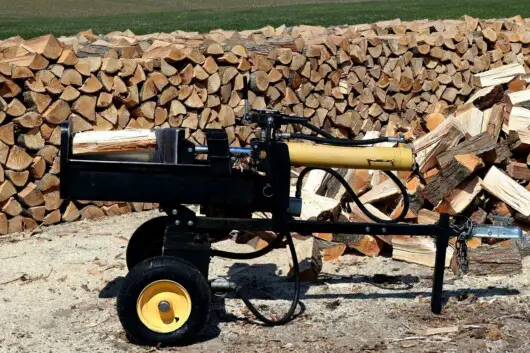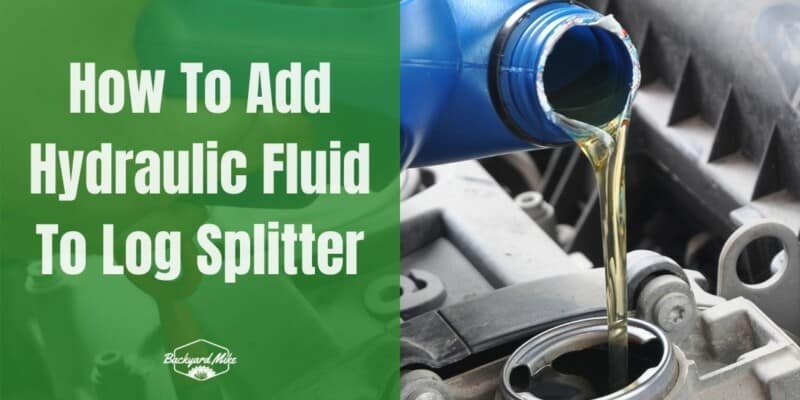Is your log splitter not working to its maximum potential due to a lack of hydraulic fluid, but you’re not certain how to add more? If so, then you’ve come to the right place because here you’ll get to know all about it.
Adding hydraulic fluid to log splitter is important, otherwise your log splitter will have noticeably less power. For adding the appropriate amount of hydraulic fluid, you’ll need to remove the oil filling plug and then fill the fluid until it’s three-fourths full.
In this article, you’ll get to know all about hydraulic fluid, how to add hydraulic fluid to log splitter, what type of hydraulic fluid you should be adding, how to know that it’s time to top up the hydraulic fluid, and tips to maintain the hydraulic fluid in your log splitter among others. Stick around to get all the answers that you’re looking for.
What is the hydraulic fluid in log splitters?
If you use a log splitter, you’ll probably be conscious of the hydraulic fluid in the tool. It’s a relatively new area for many people, and it poses several questions for the users. However, the more you know about hydraulic fluids, the better you’ll be able to use your log splitter.
Hydraulic fluid is the channel to transfer power within the hydraulic machinery. The ram mechanism on log splitters needs hydraulic fluid inside for providing the required power for splitting logs with ease. The fluid is needed for not just log splitters but forklifts, tractors, aircraft, cruise ships, and other industries.
It’s important for the hydraulic fluid to carry the correct properties for the operating conditions. It should be thermally stable, non-corrosive, fire-resistant, and carry constant viscosity while also having a long life.
How to add hydraulic fluid to log splitter?
- Place a suitable container under the tank for collecting the fluid. You need to ensure that it is big enough. Fluid in the container is good for your log splitter, but fluid on the ground isn’t.
- The suction hose should be disconnected from the bottom of the reservoir tank. For reference, reach the user manual that came with the log splitter.
- Un-thread the inlet filter carefully and then clean it using penetrating oil.
- Allow the hydraulic fluid to drain into the suitable container. The reservoir tank generally has a capacity of 3 gallons. Meanwhile, the entire hydraulic system comes with a capacity of approx. 4.7 gallons, so remember to use a big container. After that, reinstall the cylinder, pumps, hoses, and filter. Then, tighten the hose clamps to about 50-60 in-lbs.
- Now, check the hydraulic fluid levels with the help of a dipstick. Remember that you shouldn’t overfill it.
- Replace the dipstick safely and securely. Tighten it until you notice that the top of the threads is flush with the top of the pipe.
- Now comes the time to prime the pump. Remember that you should disconnect the spark plug and only then pull the recoil starter. Grip it before ripping it around 10 times.
- Reconnect the spark plug and then start the engine. If you want additional help, consult the instructions in the user manual of your log splitter.
- Use the control handle for engaging the wedge and extent to the farthest possible position on the beam. Then, you should retract the wedge back to the original starting position.
- If needed, refill the reservoir within the range that is marked on the dipstick.
- Continue the self-bleeding by moving the wedge back and forth. Do this 12 more times to remove any air trapped in the system.
What kind of hydraulic fluid should you use in a log splitter?
Typically, the manufacturer of the log splitter will mention the recommended oil options in the user manual. However, you need to have a basic understanding of what you’re looking for when buying the hydraulic fluid. Viscosity will be an important factor to consider, as it’s used to refer to the fluid’s resistance to flow. Higher viscosity will mean a longer timeframe to pass through an orifice. Moreover, it means that the fluid is thicker and comparatively harder to compress. A fluid with low viscosity will mean that the fluid is thinner and more fluid. The weather also plays a significant effect in oil viscosity. It makes low viscosity thicker until it has warmed up. The ISO number mentioned on the hydraulic fluid will be its viscosity grade. You should go for a thinner option for cold weather while choosing a midrange option for high heat.

You should go for mineral hydraulic oil viscosity grade 32 for colder, ambient operating temperatures. Meanwhile, oil viscosity grade 46 should be used for warmer climates. Many recommend synthetic oil for older machines, as it lubricates more efficiently. Log splitters use numerous hydraulic fluids during their operation. You should only be using the oil recommended by the manufacturer. This way, you’ll be able to avoid any unnecessary damage to your log splitter. Here is a breakdown of some different types of hydraulic oil options.
#1 Non-flammable hydraulic fluid
This type of fluid is considered to be non-flammable and compromises natural chemicals that won’t form a foam. An absence of foam in the hydraulic system during operation means no dirt build-up.
#2 Flammable hydraulic fluid
This oil-based fluid will give more power to the hydraulic system. Moreover, it prevents corrosion but leaves annoying sticky build-up behind. A hydraulic leak with an oil-based fluid around a small hot engine will be recipe for disaster. This is why most manufacturers prefer using non-flammable hydraulic fluid.
#3 Synthetic fluid
This type of fluid is also known as man-made chemical composition, and they’re completely non-flammable as well. However, this type of log splitter hydraulic fluid can result in corrosion easily.
How to know that it’s time to add hydraulic fluid to log splitter?
If you’re a log splitter user, you’ll likely know how difficult it can be to read a log splitter dipstick. The hydraulic fluid is so clear that it can be troublesome to take an accurate reading. However, there are a few tricks that you can learn when you’re thinking of topping up the hydraulic fluid without opening up the machine.
If the hydraulic fluid level is low, you would have already experienced a noticeable drop in performance. Logs that your log splitter once used to cut through like butter to a knife will feel difficult to cut. Moreover, your log splitter will be pushed to its limits. You should raise the front of your log splitter on a block of wood or another similar. This will push the fluid to the back of your log splitter, and you’ll get an immediate boost in performance. If this happens, it’s an indication that fluid levels are low, and you need to find out how to add hydraulic fluid to electric log splitter.
Usually, AW32 hydraulic fluid is preferred in log splitters because of the lower viscosity. This type of fluid is thinner and uses less energy to pump. This means that your log splitter will run cooler and have less wear and tear on the machine. If you occasionally run your log splitter in hotter weather, keep it to light duty with frequent cool-down breaks.
How much hydraulic oil should you use for your log splitter?
Most of the log splitter hydraulic fluid reservoirs allow between 3.5-7 liters of capacity. This depends largely on the size and power of the log splitter. It’ll be best to be absolutely certain about this and then check with the product manufacturer before you commit to the purchase. A full reservoir of high-quality hydraulic fluid can easily offer up to 150 hours of operation.
Many manufacturers advise that you should be changing the fluid after every 50 hours of use. However, if the fluid used is of the highest quality, it could give you almost 150 hours of operating time. It’ll largely depend on the type of log and how hard it can be to split, but 150 hours will be the average benchmark. If the system has been kept clean and the hydraulic oil is clear, generally the oil will be fine to continue until it becomes low.
Things to know before changing the hydraulic fluid
A decent amount of fluid generally gets drawn into the hoses and cylinders. This is why you must always remember to fill the reservoir. A hydraulic pump must be kept with a filled reservoir. Having an empty hydraulic pump could lead to damage. Moreover, this could even break the warranty condition.
You shouldn’t overfill the hydraulic fluid; otherwise it could have adverse effects. These fluids could overflow due to the heat generated by the system, as per the law of fluid expansion. This is how the hydraulic fluid mechanism generally works. Hence, you shouldn’t operate the log splitter without the proper amount of fluid level.
- When you’re checking the hydraulic fluid level, remember to tighten the dipstick to prevent any air leakage
- Avoid contaminating the fluid as contamination could lead to hydraulic system damage or engine corrosion
- Dispose of any used hydraulic fluid or engine oil at appropriate facilities
- Flush the reservoir or engine pistons with kerosene when servicing
Log splitter hydraulic fluid change is important for the lifespan of your log splitter. Moreover, it’s essential to regularly maintain the machine.
How to manage your log splitter?
How to manage hydraulic fluid in a log splitter is a fairly common question to have. Hydraulics are pressurized fluids used for powering an engine, and they’re the main power transfer source of a log splitter. Log splitters depend on the power/pressure generated by the hydraulic fluid for pushing the wedge. This amount of fluid is capable of generating a great deal of power. This power is why you can have a cord of wood without having a sore back.

A motor is used to pump the hydraulic fluid. The fluid will be pressurized as it’ll be concealed in a cylinder and hollow fluid pipe. This pressure will move the machine’s piston against your log of choice. Over time, hydraulic fluid will end up degrading and getting consumed based on oxygen, various contaminants, and excessive temperatures. This causes oil to release crud that corrodes hydraulic parts or leaves surface deposits on those parts. If the hydraulic fluid isn’t managed regularly, it could mean a shorter life span.
A properly maintained log splitter will give you faster and more efficient splitting of logs and a well-kept lawn. There are certain log splitter maintenance tips for ensuring that your log splitter continues running smoothly and efficiently for a long time. Here are some of the things to remember for maintaining hydraulic fluid in your log splitter.
#1 Check for any leaking hydraulic fluid
If you’re suspecting that there is hydraulic fluid leaking from the log splitter, you can check by passing a piece of wood or cardboard underneath the damaged area. Ensure that you’re wearing work gloves and safety gloves to protect yourself from any dangerous fluids. Most injuries with log splitter are actually hand-related injuries.
#2 Fill the hydraulic fluid
If the hydraulic fluid level is low in your log splitter, your machine will deliver noticeably less power. For adding the appropriate amount of hydraulic fluid, you should remove the oil filling plug first. After that, you should fill the hydraulic fluid unit until the level is three-fourths full.
#3 Remove any air from the hydraulic cylinder
Once you’ve added the right amount of hydraulic fluid, you should remove or bleed the trapped air from the cylinder. First, you should extend the piston rod to its maximum length and then remove the oil filling plug. After that, twist the release screw in a counterclockwise motion as quickly as you can. The piston rod draws back into the cylinder, causing the air to be released.
#4 Consider purchasing a self-lubricating log splitter
A self-lubricating log splitter will automatically clean the log splitter parts after each use. There’s a minimal effort needed to keep your log splitter well maintained. One of the biggest benefits of a self-lubricating log splitter is regularly cleaning the blades, such that they remain sharp for a longer period of time.
#5 Sharpen the blades
When it’s time for sharpening the blades on your log splitter, use a coarse metal file for sharpening any dull areas, and repair nicks and chips in the blade. For sharpening the point of the blade, smoothen the sides of the blade for reforming the sharp point. After that, run a file metal file alongside the edges of the blade to finish the process.
#6 Regularly clean the log splitter
If your log splitter isn’t self-cleaning, ensure that you clean the machine regularly for removing oil, debris, and grease. Ensure that the machine is always turned off before you perform any cleaning. Moreover, remove any debris around the machine so that nothing gets lodged in the log splitter during operation.

#7 Store it in a dry place
Avoid any damage from water and mold by storing your log splitter in a dry storage area. A garage or shed will be the perfect option if the building unit stays dry the entire year. Moreover, cover the log splitter with a waterproof tarp to give extra protection.
#8 Replace the worn-out log splitter parts
If any log splitter part is broken or worn out, ensure that you’re replacing them before operating the log splitter. Compare the part and number of the parts when you’re ready to make the purchase. This will help ensure that you’re buying the right parts for your specific log splitter.
Now that you’ve learned the basic maintenance tips for log splitters, you’re ready to keep it running for long. For proper maintenance of your log splitter, make sure that you’re referring to your operator’s manual for repair and maintenance instructions specific to your log splitter’s model. Your log splitter parts will run efficiently and correctly so that you can split wood at a faster pace.
Conclusion
Thank you for reading. Hopefully, now you know a lot more about hydraulic fluid, how to add hydraulic fluid to log splitter, what type of hydraulic fluid you should be adding, how to know that it’s time to top up the hydraulic fluid, and tips to maintain the hydraulic fluid in your log splitter among others. If you want the best working conditions for your log splitter, then adding hydraulic fluid when needed will be important. If the hydraulic fluid becomes low, your log splitter will have noticeably less power. For adding the appropriate amount of hydraulic fluid, you’ll need to remove the oil filling plug and then fill the fluid until it’s three-fourths full.


